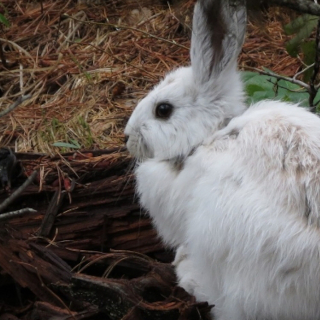Mills Lab publishes new article in Science: Research identifies areas where evolution could rescue animals threatened by climate change
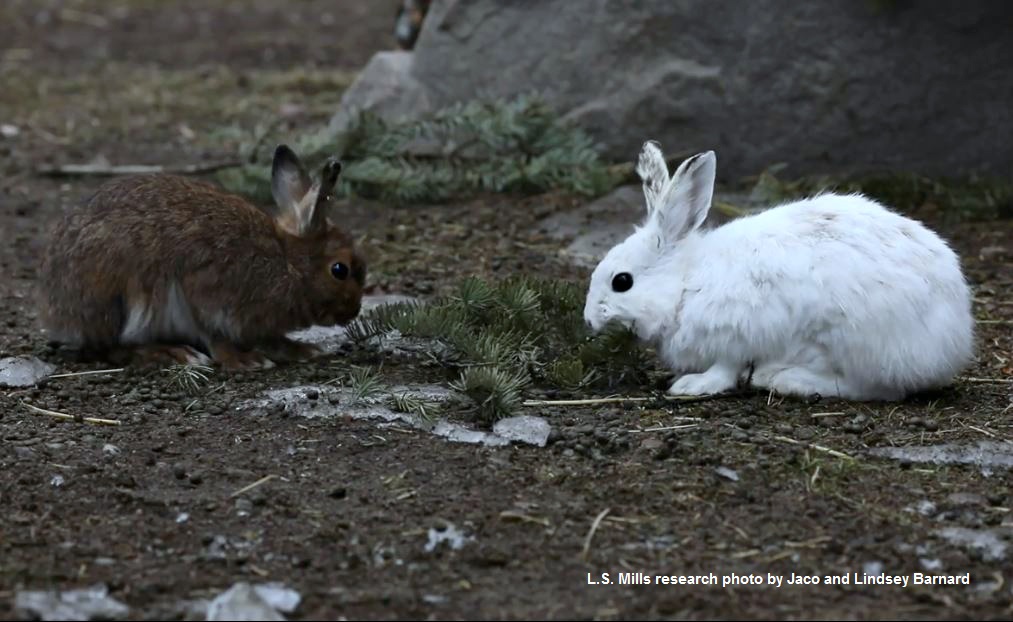
On February 15, our article “Winter color polymorphisms identify global hot spots for evolutionary rescue from climate change” came out as a ‘first release’ online in Science, appearing in print in its final version in the March 2, 2018 issue. This paper has been a thrilling collaborative project over years of thinking and dedicated work to collect and analyze the data. It includes the energy and passion of the next generation of scientists, with half of the co-authors being Mills lab students or post-docs. It also harnesses the power of international expertise, with co-authors from 5 countries. For me, this means that both the findings of this paper, and the process of getting there with this incredible team, has left me with a profound sense of optimism for the future.
How did this paper come about? We know with certainty that humans are driving acceleration in human caused climate change, but what does that change mean for the critters on planet earth? Well, that depends on the actions that humans take, starting now. Of course, reducing our global C02 footprint is ultimately essential, but are there other steps that people could take now to minimize extinctions of wild animals as the climate changes? That’s what motivated this study: the desire to know what this remarkable trait that we have been studying for almost a decade -- seasonal coat color -- could tell us about how adaptation to climate has already shaped species and might be able to foster future persistence to climate change.
In this paper we first describe how seasonal coat color – shared by 21 photogenic species across the northern hemisphere – is directly shaped by climate. All of these species literally live or die by the effectiveness of their camouflage, which evolution has exquisitely crafted to match the average duration of winter snow. The trigger for the color molt from brown to white is daylength, which as we know, is an excellent metronome that tracks the coming and going of winter. But, when a daylength-triggered trait (coat color) confronts a decrease in snow duration, the winter white animals face more and more deadly days of being white light bulbs on a brown snowless background. We’ve published on all this previously with snowshoe hares, also showing that mismatched hares are more likely to be killed, and do not appear to recognize their mismatch or behave to reduce mismatch (that is, ‘plasticity’ appears to be limited). In this Science paper, we extended the perspective to all the other coat changing species around the world, and focus on a really interesting twist: long-term evolution has shaped some individuals in each of the species to remain brown in the winter, an adaptation to reduced or no snow (for example in southern or coastal areas). For 8 species (all we could get data for; see below) we mapped the range-wide distribution of the winter white and winter brown morphs, as well as the regions where both brown and white winter individuals would be expected to be found together. Because areas with the most variation evolve towards brown most quickly, and could then disperse those genes to adjacent winter white populations, these ‘polymorphic’ zones emerge as hotspots for rapid evolutionary response to climate.
A side note on the methods to do all this mapping, because with this wonderful team it was very fun. Much of the work was old-school natural history sleuthing at its best, seeking winter specimens with known coat color and a precise collection location. Our team pored through the old literature, and visited 26 museums globally to collect 2,700 samples originating from 60 countries (See accompanying blogs by PhD student Alex Kumar and former Mills lab undergrad Kairsten Fay). Then we implemented a major spatial modeling effort to use those known coat color samples to predict expected winter coat color across the entire ranges of the 8 species (there weren’t enough data for the other species). Areas with high probability of winter white are likely ‘winter white’ populations, low probability of winter white are ‘winter brown’ populations, and roughly 50:50 areas designate polymorphic zones, where winter white and brown individuals are likely to be found together. These are the ‘hotspots for evolutionary rescue from climate change.’ Finally, we lit up places on earth where 2 or 3 different species (of the 8) had overlapping polymorphic zones.
We show that winter coat color has been shaped by evolution to track climate, specifically snow duration, snow transience, and seasonality. As we say in the paper: “Winter white populations were more likely in regions with more persistent snowpack that tended to be more northern, higher elevation and less maritime. These results suggest that strong natural selection for camouflage against varying snow duration underlies phenotypic variation in winter color morphs across environmental gradients.”
Next, we ask how these evolutionary solutions to different amounts of snow across their range could be harnessed to help with conservation in a rapidly changing climate. In previous fieldwork with snowshoe hares we found that the mortality cost of being color mismatched – coupled with severe decrease in snow duration over the next century (eg 30 days fewer days with snow by mid-century, 50 by late century in our Montana study areas) – would, without evolutionary change, be highly likely to cause severe population declines towards extinction. Other researchers around the world have found that coat color mismatch against decreased snow duration may have already contributed to range contractions for snowshoe hares in the U.S., and mountain hares and ptarmigan in Europe. So in this case, with high likelihood of steep population declines over the next century, an evolutionary change towards winter brown would be considered evolutionary rescue.
And where would the ‘hotspots’ for evolutionary rescue be? Well, a fundamental biological principle – dare I say, a ‘law’ of evolutionary biology – holds that the secret sauce for rapid evolutionary change is the presence of rich variation for selection to act on. In the case of seasonal color change, the ingredients for rapid change are found in the polymorphic populations, with winter brown and winter white individuals living together. Here in the polymorphic zones the populations are most likely to rapidly evolve towards winter brown, and to disperse the winter brown genes out into the adjacent winter white populations: hotspots for evolutionary rescue.
To wrap up, here’s how I answered a question from a journalist who asked: “What message do you hope your study sends to policymakers looking to protect wildlife from climate change? Without these measures, is likely that some of species included in your study could be threatened with extinction?”
First, I answered, I hope that the picture of white animals on brown snowless ground “paints a thousand words” that shows that with continued human-caused climate change and reduction in snow duration, winter white animals on a brown snowless winter background will be in trouble. I hope that is yet another push for policymakers to reduce the global carbon footprint. But I hope it also helps them see that extinction is not inevitable: that other short-term, yet effective, options are available for protecting wildlife in the face of climate change. The exact same conservation measures that have been advocated for half a century – to maintain habitat sufficient to support large and connected populations – are the exact recipe for fostering nature’s ability to help shape animals to endure rapid environmental change! In other words, evolution is not magic or omnipotent, and ultimately we must pursue a reduction in the greenhouse gases that cause climate change. BUT: we needn’t panic; rather, pushing for large and connected populations that hold the special sauce to empower nature’s adaptation engine to sustain wild animals through substantial challenges. This is something that any citizen, community leader, land manager, or politician could do in the short term to help wild animals persist in the face of climate change.
As for the second question, the answer must be: it depends on what people do starting now! In other words, if we do not make gains in reducing greenhouse gases, and do not take action to foster adaptation, then the prognosis will be grim for many species in the next century. BUT: with action to reduce greenhouse gases (a long term proposition) coupled with hard work to maintain large and connected populations that best foster rapid evolutionary change, then there’s considerable optimism for the persistence of wild species.
Oh, and by the way, if this topic interests you, keep checking back because we are making progress on lots of fronts. For example, PhD student Marketa Zimova has a recently accepted review paper on all things seasonal coat color to be published soon, very soon!
L. Scott Mills, PhD
Photos:
These images show brown and white snowshoe hares on both snow and bare ground at a University of Montana research facility. (L.S. Mills research photos by Jaco and Lindsey Barnard)
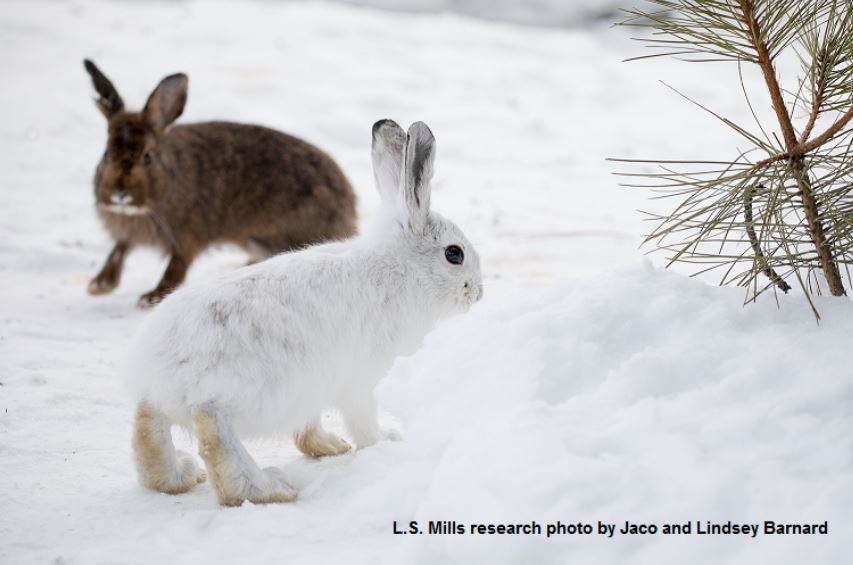
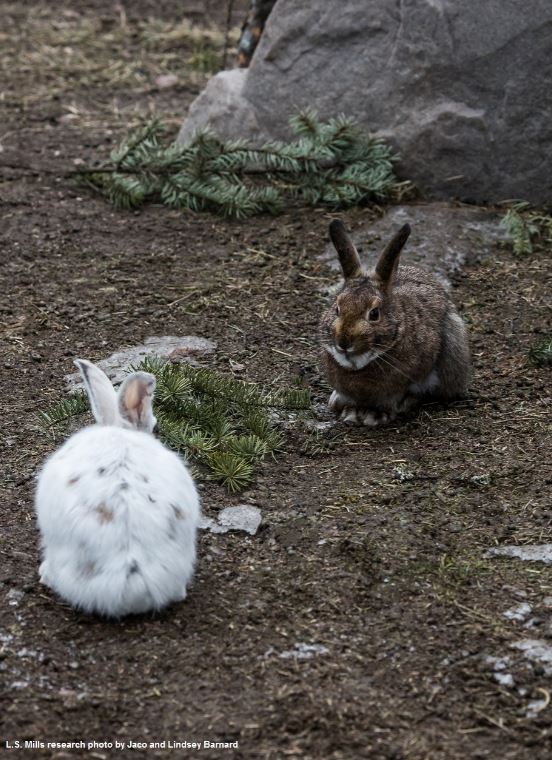
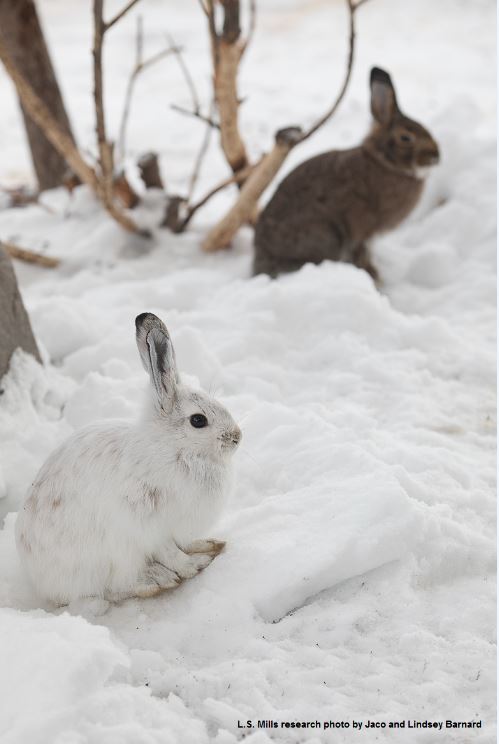
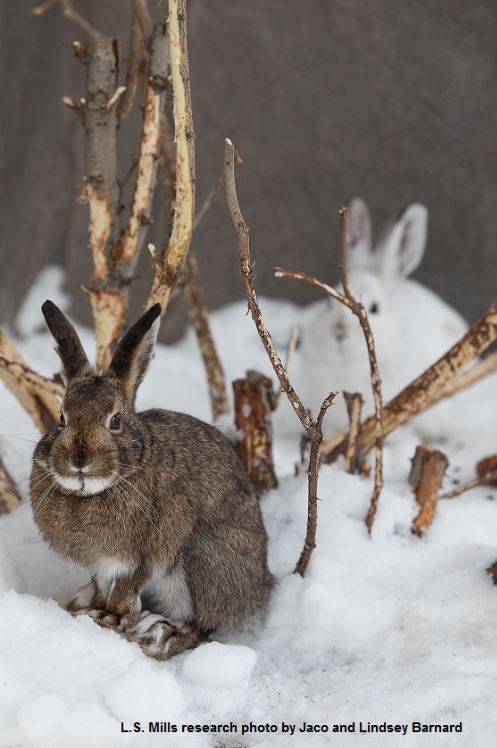
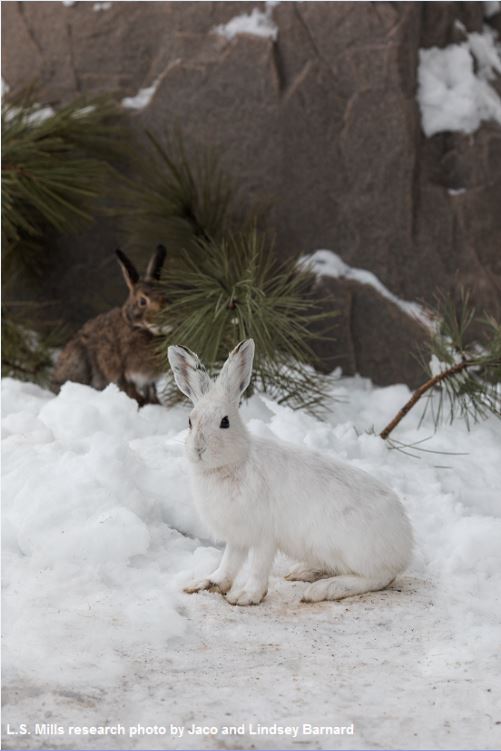
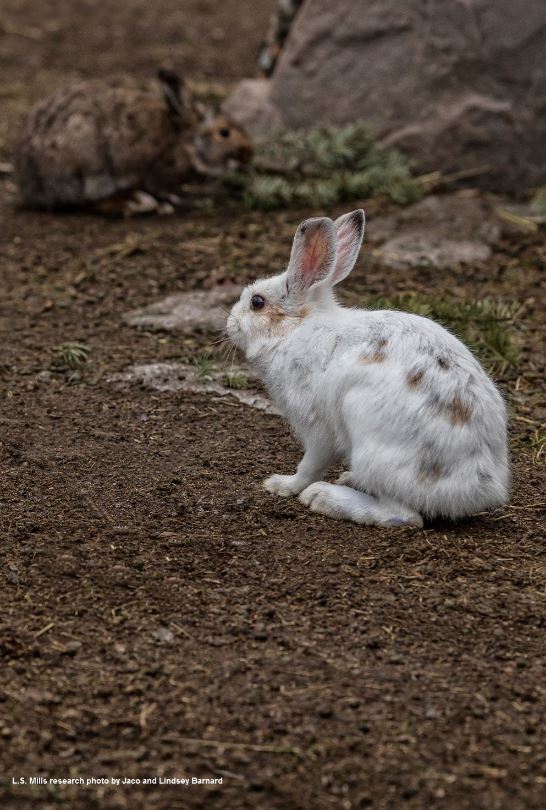
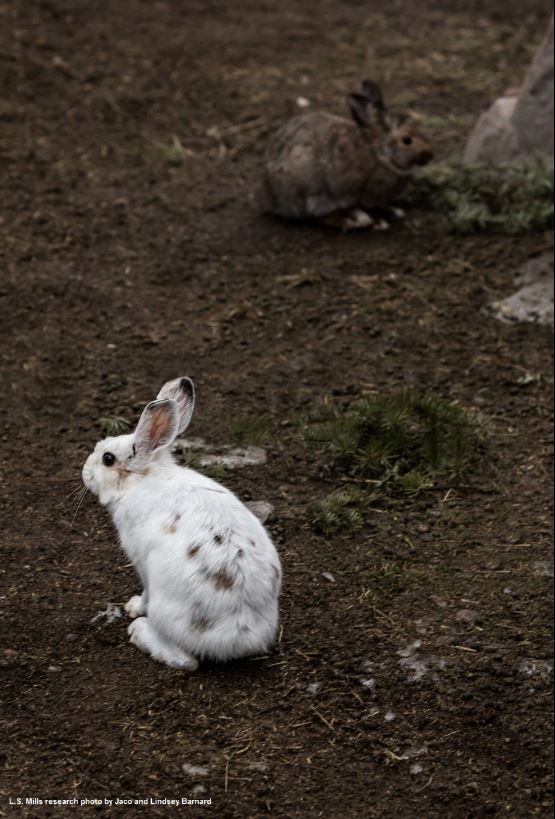
Video: Brown and white winter hares from Mills’ research
Video description: These snowshoe hares are from a polymorphic population in Washington state, where both the brown and white winter forms coexist in what the authors consider to be a “hotspot for evolutionary rescue from climate change.” Here we see how winter brown and winter white hares show striking differences in camouflage when snow is absent, with the brown forms better matched against snowless ground. Hares were filmed at L.S. Mills’ captive facility at the University of Montana, specifically designed to mimic the natural environment and to allow researchers to monitor the precise timing of seasonal coat color molts and individual responses to camouflage mismatch. Different hares are recognized using special hair dyes applied on their ears. (Video footage taken by Jaco and Lindsey Barnard)
